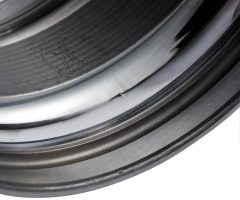If a rolling bearing “packs up” after some time despite correct bearing selection, lubrication and handling, it is very likely to be fatigue damage. Fatigue damage occurs when the fatigue life of a rolling bearing has been reached. Even with greater loads, the occurrence of classic fatigue damage is possible after a certain period. Nevertheless, such “natural“ fatigue damage occurs relatively rarely. Experience shows that bearing damage due to insufficient lubrication or faulty mounting occurs much more frequently.
Probably the main feature of fatigue damage is rolling contact fatigue, which is caused by the repetitive stress between rolling elements and the bearing raceways. Structural changes that can be observed in a sectional view are typical with rolling contact fatigue. Also, rolling contact fatigue leads to cracking under the surface and material chipping on the surface (also called spalling or flaking). Flaked rolling bearing material is another sign of fatigue damage. There are two types of fatigue damage: Subsurface-initiated fatigue and surface-initiated fatigue.
Fatigue below the surface
With regard to subsurface fatigue, the shear stress hypothesis of Lundberg and Palmgren should be mentioned, which provides an explanation for its occurrence. Depending on the material, the applied load, the temperature, the material purity and the microstructure; structural changes and microcracks form. These cracks then expand to such an extent that they reach the surface and material flakes at the surface. The resulting material flaking usually runs parallel to the surface.


Fatigue originating at the surface
Lubrication is essential for a long rolling bearing life. However, insufficient lubrication leads to metallic contact between rolling elements and the raceway. Nevertheless, even with generally perfect lubrication, indentations with raised edges higher than the lubricant film thickness (< ≅ 1µm) can occur due to contamination, overloading and raceway damage. In addition to the rolling contact between the rolling elements and the raceways, these indentations also cause metallic contact between them. This metallic contact leads to smoothening of the surfaces (plastic deformation), which in turn results in bearing damage.
Micro Pitting
One type of surface-induced fatigue is micropitting, which can also be regarded as a preliminary stage of chipping and cracking. Typically, pitting appears as a matt grey colour on the affected rolling bearing components. It is characterised by shallow, tiny pits and occurs when a rolling bearing is subjected to a relatively low load and the components slide against each other rather than rolling. These sliding components can be avoided – provided that ball rolling elements are subjected to a minimum load of 0.01 C and cylindrical rolling elements (the rolling elements of roller bearings) are subjected to a minimum load of 0.02 C. In general, the higher the loads and the poorer the lubrication condition, the more significant cracks can occur on the rolling bearing.
Micropitting not only has a negative impact on the bearing’s service life, but also on the noise generation. Furthermore, micropitting leads to a loss of material, deteriorated profiling and ultimately to excess pressure near the surface. Furthermore, the development of flaking is preceded by micropitting. It can therefore be said that micropitting occurs first, which later develops into flaking and finally cracks.
Rolling bearing damage can be detected at an early stage by determining and measuring the rolling frequencies. This is done with the help of vibration analysis, which should ideally be combined with temperature monitoring. Early detection of bearing damage means that machine downtime and repair time can be planned. Rolling bearing manufacturers such as NTN offer suitable equipment and advice for vibration analysis as a service.
You may also be interested in
Corrosion
Have you ever heard of corrosion? Corrosion is basically divided into two main forms according to ISO 15243: Corrosion by moisture and fretting corrosion. Fretting
Cracks and fractures
Cracks and fractures are not only extremely annoying, they are also one of the most common types of rolling bearing damage. The reasons for such
Electro-erosion
This article (based on ISO 15243) is all about electro-erosion – but what is it? Electro-erosion is understood to be a local structural change and
Lubrication
Nothing works without lubrication: Every bearing runs with grease or oil lubrication, which is the basic prerequisite for avoiding metallic contact of the bearing components,
Plastic deformation
You may have already learned interesting facts about damage types such as fatigue damage or wear in our other articles. This article concerns another type
Wear
Rolling bearings, like other mechanical components, encounter problems such as wear. Wear describes the progressive removal of material from surfaces and is caused by two




